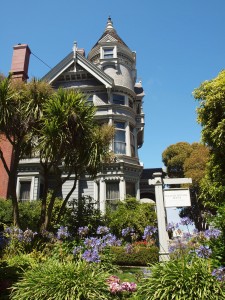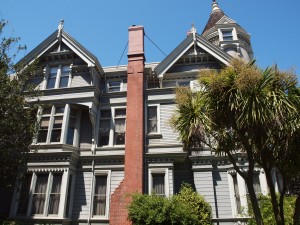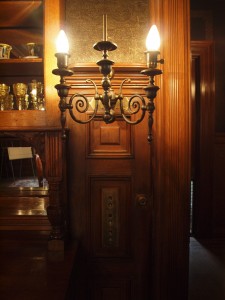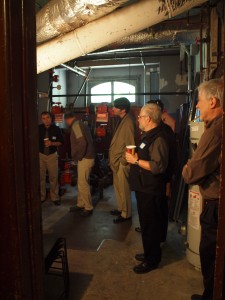
The Haas-Lilienthal House in Pacific Heights, San Francisco, is having a sustainability management plan prepared.
Can a house museum be relevant for today and play a part in greening our planet? Why not?! The Haas-Lilienthal House was built in 1886 and listed in the National Register of Historic Places in 1973. San Francisco Architectural Heritage owns the building and runs their advocacy organization from offices in the house, which is the only “painted lady” in the city open for public tours. “Heritage’s” mission is to preserve and enhance San Francisco’s unique architectural and cultural identity. I am working with “Heritage” to develop a Sustainability Management Plan for the site and the organization to broaden the resource use of the site, expand the audience of the organization and to prove the relevance that a house museum can continue to have in our culture. I spent last week in San Francisco working with my client and partners using an “eco-charrette” format to initiate the process.
An Eco-Charrette opens up Dialogue
An eco-charrette is a working session to discuss a project’s goals and objectives, develop an outline for the sustainability vision, review operations and upcoming potential capital improvements. The charrette process fosters an environment in which members of the project team can contribute ideas, express concerns and recommend actions for the project and creates a foundation upon which to build relationships, strengthen communication and help define project direction. (This definition from Ralph Dinola from Green Building Services in Portland, OR ). Our eco-charrette was split into 2 sessions – one for staff and board to develop baseline goals and the second for partners to help us think through our overarching goals: Expand the symbol of the organization to act as a model of sustainable preservation and advance the leadership role of the Haas-Lilienthal House and Heritage to its current partners as well as reach out to new partners.
Eco-Charrette Part 1 was an internal team meeting with staff and board members to establish the overall sustainability vision of the organization for the house and review operations and upcoming capital improvements in order to determine the baseline approach for “greening” the site. Part 2 was a Partner’s meeting with sustainability, architecture and preservation experts from the region who assisted in reviewing the project’s goals and used relevant case studies and experience to help develop a road map which will guide Heritage in creating a model of sustainability.
Both meetings were incredibly fruitful and set the stage for the next phase of the Haas-Lilienthal House. Some additional internal goals we identified were: improve accessibility to accommodate more events, reactivate appropriate Victorian passive design features and maintenance approaches, improve neighborhood and community relationships, integrate the mission of the house with the mission of the organization, and become LEED certified as a “stamp of approval” that is readily recognized.
Our partners encouraged our goals and pushed us to “stretch” our goals beyond what we thought was possible. Mark Huck, Restoration Architect at the California SHPO reported that they are seeing many projects come through for review that are going for rehabilitation tax credits and LEED Core & Shell. Margie O’Driscoll, the Executive Director of AIA San Francisco shared her experience renovating their offices at the historic Hallidie Building using LEED Commercial Interiors and achieving LEED Gold; she suggested “Heritage” publicly document the process we follow. Chandler McCoy from the Presidio told us that a dozen historic buildings at the Presidio have been LEED certified where they require LEED for all permitted projects and they haven’t replaced any windows! Brendan Bloom, representing the Northern California Chapter of USGBC, suggested that we could maintain the existing knob and tube electrical wiring as long as we focus on getting the plug loads down. John Andary, the Bioclimatic Design Leader from the Integral Group encouraged us to “stretch” our goals and strive for LEED Platinum or net zero and that we closely track the design and construction process so we can share the message. David Malman from Architectural Lighting Design reminded us that historic buildings like Haas-Lilienthal were primarily daylit and while historic incandescent lighting is often seen as “bad”, wisely controlling its use and attacking the loads may achieve as much energy savings as installing LED or CFLs might. Anthony Veerkamp from the National Trust Western Regional Office agreed that improvements to the lighting would expand the use of the building and suggested that embracing its Victorian background may even encourage “steampunk” events!
Evaluating LEED for a historic building

Restoring the historic original wood windows at the Haas-Lilienthal House will be a key component of the LEED certification.
Our baseline target is to implement some much needed capital improvements projects and overhaul the maintenance and stewardship policies and processes at the House – targeting LEED Gold for LEED Existing Buildings: Operations & Maintenance, and reviewing the options for LEED Core & Shell or LEED NC. LEED is not an end in itself but a tool that helps create more sustainable built environments by providing a framework for design, construction and evaluation. It is best when used as an integrated planning and design process to achieve real result on the ground, and this is the perfect time to be evaluating the options.
The greening of the President Lincoln’s Cottage Visitor Education Center, a project I worked on at the National Trust which received LEED Gold, demonstrates the remarkable degree to which historic buildings are compatible with LEED, in this case LEED NC2.2 standards – indeed, many other preservation projects have also earned LEED certification with relative ease. Out of the 69 points offered under LEED-NC v. 2.2, about 20 are building-type neutral, meaning any building or project type—renovation or new construction—can get these points. Another 10 points directly support preservation activities. Recent projects suggest that any existing building should be able to achieve a “certified” rating with very little effort. Earning “silver” requires a bit more effort, and even “gold” is readily achievable, as the Lincoln Cottage VEC demonstrates. (LEED is undergoing massive changes and is currently out for 2nd public comment; watch the National Trust blog for my review of the changes later this week.)
What’s Next?

Evaluating the lighting fixtures and system in the Haas-Lilienthal House will be another key component of the work.
Following in the footsteps of the VEC model, and many other historic buildings achieving LEED EB: O&M such as the Colorado State Capitol, National Geographic headquarters and even the Empire State Building, “Heritage” is looking to use the Haas-Lilienthal House as the platform for remaking and greening the musty historic house museum as a type. Heritage has great potential as an advocacy organization that owns and works out of a historic house museum. As I declared in my last blog, “Just because historic preservation has evolved, doesn’t mean that we should ignore the preservation tool that saved so much of our early historic fabric (the house museum).” With planned capital improvement projects such as – exterior restoration and repairs including windows and the wrought iron fence, barrier free improvements, life safety upgrades, upgrading of the residential bathrooms in 2 rental units, and upgrading the heating system – and a rethinking of the business plan for Heritage also happening, the organization is well positioned to rethink the house museum without losing its meaning or “heritage”.
And if you’d like to “subscribe” or follow this blog, True Green Cities, please sign up through the “Subscribe” button at the bottom left of this page. You’ll receive a daily recap when new blogs are posted.

